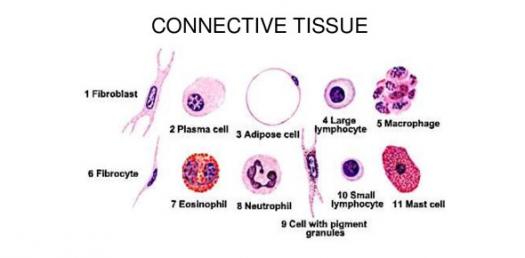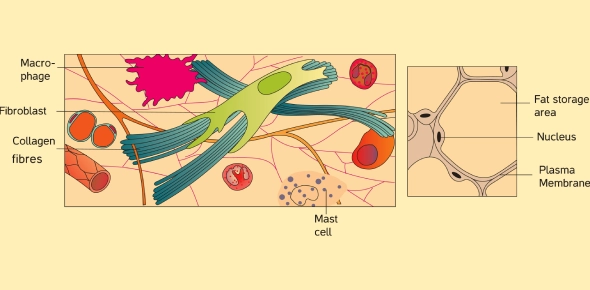Connective Tissues Lesson: Structure, Types, Roles
Lesson Overview
- What Are Connective Tissues and Why Are They Essential to Body Structure and Function?
- How Are Connective Tissues Classified Based on Structure and Function?
- What Are the Key Cells and Matrix Elements in Connective Tissues?
- What Are the Functions and Features of Areolar Connective Tissue?
- What Defines Adipose Tissue and What Are Its Physiological Roles?
- How Do Dense Connective Tissues Differ in Structure and Mechanical Function?
- What Are the Three Major Cartilage Types and How Do They Function?
- How Is Bone Structured to Support and Protect the Body?
- What Is Blood Tissue and How Does It Function in Circulation and Immunity?
- What Are Specialized Structures Seen in Bone and Cartilage Slides?
- Conclusion
When Jim blanked out during a lab practical trying to explain the difference between areolar and dense tissue, he realized memorizing slides wasn't enough. Understanding Connective Tissues means learning how structure connects to function. This lesson breaks down every type so you can analyze tissues with complete clarity.
What Are Connective Tissues and Why Are They Essential to Body Structure and Function?
This section introduces connective tissues as versatile and vital components of the body's structural and functional framework.
Connective tissues represent the most abundant and widely distributed tissues in the human body. These tissues serve to support, bind, protect, and insulate organs and other tissues. Unlike epithelial tissues, connective tissues are composed of relatively few cells embedded within an extensive extracellular matrix (ECM). This ECM includes ground substance and fibers that determine the mechanical and physiological properties of each connective tissue subtype.
Core Functions of Connective Tissues:
- Connect and support organs and tissues
- Provide mechanical strength and elasticity
- Facilitate nutrient and waste exchange
- Store energy in the form of fat
- Contribute to immune defense and tissue repair
How Are Connective Tissues Classified Based on Structure and Function?
This section categorizes connective tissues into proper, supporting, and fluid types and outlines their structural and functional distinctions.
Connective tissues are classified into three main groups:
1. Connective Tissue Proper:
- Loose Connective Tissue: Areolar, adipose, and reticular
- Dense Connective Tissue: Dense regular, dense irregular, and elastic
2. Supporting Connective Tissue:
- Cartilage: Hyaline, elastic, and fibrocartilage
- Bone: Compact and spongy
3. Fluid Connective Tissue:
- Blood and lymph
Table: Major Types of Connective Tissues
| Type | Subtypes | Key Functions |
| Connective Tissue Proper | Areolar, Adipose, Dense, Elastic | Support, cushioning, elasticity |
| Supporting Tissue | Cartilage, Bone | Structure, protection, mineral storage |
| Fluid Tissue | Blood, Lymph | Transport, immunity |
What Are the Key Cells and Matrix Elements in Connective Tissues?
This section explains the cells and extracellular materials that define connective tissue composition.
Connective tissues consist of cells and extracellular matrix (ECM). The ECM is made of ground substance and protein fibers. Cells within the matrix maintain, repair, and defend tissue integrity.
Common Connective Tissue Cells:
- Fibroblasts: Secrete collagen and other ECM components; dominant in areolar tissue
- Adipocytes: Store triglycerides and regulate metabolism
- Chondrocytes: Occupy lacunae in cartilage and maintain the cartilaginous matrix
- Osteocytes: Reside in lacunae in bone; maintain bone matrix and communicate via canaliculi
- Leukocytes (WBCs): Mediate immune defense
- Mast Cells: Secrete histamine and heparin during inflammation
- Macrophages: Engulf pathogens and cellular debris
Extracellular Matrix Components:
- Ground Substance: Viscous medium composed of glycosaminoglycans (GAGs), proteoglycans, and interstitial fluid
- Fibers:
- Collagen fibers: Provide tensile strength (Type I in bone, tendon)
- Elastic fibers: Confer elasticity (abundant in elastic cartilage and ligaments)
- Reticular fibers: Form networks for cellular support in lymphoid organs
Table: ECM Composition and Roles
| ECM Component | Primary Role |
| Ground Substance | Nutrient exchange, shock absorption |
| Collagen | Strength, resistance to stretch |
| Elastic fibers | Flexibility, resilience |
| Reticular fibers | Structural framework for soft tissues |
What Are the Functions and Features of Areolar Connective Tissue?
This section focuses on the composition, location, and importance of areolar tissue.
Areolar connective tissue is a type of loose connective tissue with a gel-like ground substance and an irregular arrangement of collagen and elastic fibers. Fibroblasts are the most abundant cells. It is found beneath epithelial tissues and around blood vessels.
Areolar Tissue Characteristics:
- Loosely arranged fibers
- High vascularity
- Supports and cushions organs
Functions:
- Holds tissue fluids
- Provides immune defense through resident macrophages and mast cells
- Anchors epithelial tissue to underlying structures
Locations:
- Papillary layer of dermis
- Surrounding capillaries
- Mucous membranes
What Defines Adipose Tissue and What Are Its Physiological Roles?
This section elaborates on adipocytes, fat storage, and the metabolic significance of adipose tissue.
Adipose tissue is composed almost entirely of adipocytes. These cells appear as signet rings under the microscope due to a central lipid droplet that pushes the nucleus to the periphery. Adipose tissue is both a structural and an endocrine tissue.
Functions:
- Energy storage as triglycerides
- Thermal insulation
- Protection of vital organs
- Secretion of adipokines like leptin, resistin, and adiponectin
Types:
- White Adipose Tissue (WAT): Energy storage and insulation
- Brown Adipose Tissue (BAT): Thermogenesis in infants via mitochondria-rich adipocytes
How Do Dense Connective Tissues Differ in Structure and Mechanical Function?
This section analyzes the collagen arrangement and mechanical roles of dense connective tissues.
Dense Regular Connective Tissue:
- Collagen fibers run parallel
- Provides tensile strength in one direction
- Found in tendons and ligaments
Dense Irregular Connective Tissue:
- Collagen fibers arranged irregularly
- Withstands stress in multiple directions
- Found in dermis and organ capsules
Elastic Connective Tissue:
- Rich in elastic fibers
- Found in large artery walls and vocal ligaments
- Allows tissue to stretch and recoil
Table: Dense Connective Tissues
| Tissue Type | Fiber Orientation | Common Locations | Main Function |
| Dense Regular | Parallel collagen | Tendons, ligaments | Unidirectional tension |
| Dense Irregular | Irregular collagen | Dermis, joint capsules | Multidirectional tension |
| Elastic | Elastic fibers | Aorta, vocal cords | Elasticity and recoil |
What Are the Three Major Cartilage Types and How Do They Function?
This section explains cartilage subtypes, structural properties, and anatomical roles.
Cartilage is an avascular connective tissue with chondrocytes located in lacunae within a semi-solid matrix.
Hyaline Cartilage:
- Most common cartilage
- Matrix appears glassy and homogenous
- Found in costal cartilage, trachea, articular surfaces
- Provides smooth surfaces for joint movement
Elastic Cartilage:
- Rich in elastic fibers
- Found in auricle of ear, epiglottis
- Maintains shape and flexibility
Fibrocartilage:
- Dense collagen fiber bundles
- Found in intervertebral discs, pubic symphysis
- Resists compression and absorbs shock
Table: Cartilage Comparison
| Cartilage Type | Matrix Components | Example Sites | Functional Advantage |
| Hyaline | Fine collagen fibers | Trachea, nose, joints | Flexibility and support |
| Elastic | Elastic fibers | Ear, epiglottis | Shape retention |
| Fibrocartilage | Dense collagen fibers | Intervertebral discs | Shock absorption |
How Is Bone Structured to Support and Protect the Body?
This section delves into bone histology, matrix composition, and osteocyte organization.
Bone, or osseous tissue, is a mineralized connective tissue with a rigid extracellular matrix. It contains lamellae, lacunae, and canaliculi arranged into cylindrical units called osteons.
Bone Cells:
- Osteoblasts: Bone-forming cells
- Osteocytes: Mature bone cells residing in lacunae
- Osteoclasts: Multinucleated cells responsible for bone resorption
Matrix Composition:
- Organic component: Type I collagen
- Inorganic component: Hydroxyapatite (Ca10(PO4)6(OH)2)
Compact Bone Features:
- Central (Haversian) canal surrounded by concentric lamellae
- Canaliculi connect osteocytes for nutrient exchange
What Is Blood Tissue and How Does It Function in Circulation and Immunity?
This section reviews blood's cellular and plasma components and their systemic functions.
Blood is a fluid connective tissue with a plasma matrix and suspended cells. It transports gases, nutrients, hormones, and immune cells.
Plasma:
- 90% water
- Contains proteins (albumin, fibrinogen), nutrients, hormones
Formed Elements:
- Erythrocytes (RBCs): Anucleate; transport oxygen using hemoglobin
- Leukocytes (WBCs): Nucleated; immune defense
- Platelets: Anucleate fragments; involved in clotting
Functions of Blood:
- Distributes oxygen, CO2, nutrients, and hormones
- Protects against pathogens via immune cells
- Regulates pH and body temperature
What Are Specialized Structures Seen in Bone and Cartilage Slides?
This section identifies histological features observed under the microscope.
Lacuna:
- Small space containing a chondrocyte or osteocyte
Canaliculi:
- Microscopic channels that connect osteocytes in compact bone
Perichondrium:
- Connective tissue sheath supplying cartilage with nutrients
Lamellae:
- Concentric rings in compact bone matrix
Key Concept: Bone is vascularized and metabolically active; cartilage is avascular and depends on diffusion.
Conclusion
This detailed exploration of connective tissues-ranging from areolar to bone-provides students with the anatomical and histological foundation needed for exams and future medical studies. The lesson integrates structural knowledge, histological identification, and clinical relevance, preparing learners for critical thinking in biology, anatomy, and health sciences.
Rate this lesson:
 Back to top
Back to top

